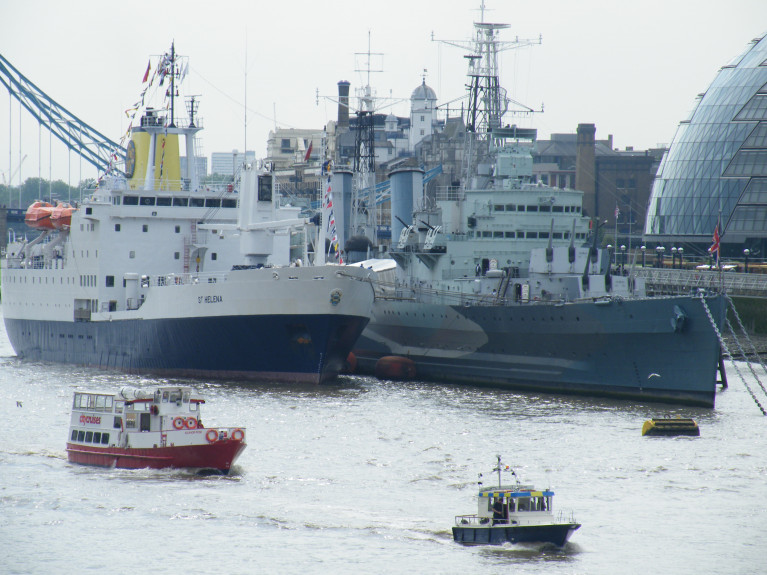Displaying items by tag: National (UK) Historic Ships
In Times of Covid National Historic Ships UK Announce 'Virtual Flagship' Award to HMS Belfast
Across the Irish Sea the National Historic Ships UK which advises the Department of Culture, Media & Sport on grant giving organisations for ship conservation has in response to the impact of Covid-19 on the maritime heritage sector, made a significant change to its Flagship of the Year scheme.
The organisation which is the official voice for historic vessels in the UK, which usually reflects the cruising programme or visitor numbers of each craft, have instead welcomed applications for ‘virtual flagships’ in recognition of the fact that many historic vessels have had to cease operations, cancel or postpone events through circumstances beyond their control.
The Flagship Awards provide an opportunity to demonstrate and celebrate the value of our sector during these exceptionally challenging times. Our 2020 Flagships have been selected for their tenacity in continuing to raise their profile throughout the Covid-19 outbreak by online activities, social media, developing learning resources, offering virtual tours and other creative means. They will have our full online support over the coming months to help promote their vessels.
Hannah Cunliffe, Director of National Historic Ships UK, commented: “I am delighted that we are able to offer these Awards again as a means of supporting the sector at a time when it needs our help most. The creativity and resilience these vessels have shown in developing new online engagement packages to meet the current situation has been impressive and I look forward to working with them all in the months ahead.”
Flagships are expected to actively promote the role of National Historic Ships UK by sharing social media posts, publicising activities such as the annual Photo Competition, the Excellence in Maritime Heritage and Marsh Volunteer Awards. They will also be flying the flag as ambassadors for the UK’s maritime heritage sector.
The Flagships awards announced last month, receive grants of £500 and £250 respectively to be spent on the vessel or related digital activities and a special broad pennant to fly at the masthead once the ship is active again.
The National Flagship for 2020 is:
HMS Belfast for more infor click here
The Museum Ship which Afloat adds was launched on St. Patrick's Day 1938 at Harland & Wolff, Belfast is berthed in the Pool of London (see RMS St. Helena's historic only call to the UK capital) .
The former UK Royal Navy 'Southampton' class steam turbine powered battle-cruiser had a career spanning 25 years in active service. Among them saw HMS Belfast take part in WW2 and also during the Korean War in the 1950's.
A final visit to the ship's namesake city took place in the early 1960's.
Due to the determination of a group of men led by HMS Belfast's former captain, now Rear Admiral, Sir Morgan Morgan-Giles DSO OBE CM, they decided to save the ship and this led to the former warship brought to London.
In 1971 the HMS Belfast Trust was formed which saw the ship sail located to the Pool of London on the Thames as a floating museum which opened to the public that year on 21 October. Seven years later HMS Belfast became part of the Imperial War Museum.
A more recent highlight saw HMS Belfast selected to take part in the Avenue of Sail, for the Diamond Jubilee Pageant on 3 June 2012.
The 2020 Regional Flagships are:
Medway Queen (South East), Paddle Steamer
www.nationalhistoricships.org.uk/register/46/medway-queen.
Zebu (North West), Tall Ship
www.nationalhistoricships.org.uk/register/3474/zebu
ss Explorer (Scotland East), Research Vessel
www.nationalhistoricships.org.uk/register/26/ss-explorer
Spartan (Scotland West), Museum Ship
www.nationalhistoricships.org.uk/register/622/spartan
For more information on our winning entries visit www.nationalhistoricships.org.uk/page/our-flagships-2020
In addition to the National Register of Historic Vessels (NRHV), which lists over a thousand significant historic vessels: www.nationalhistoricships.org.uk/registers
There are currently over 1600 vessels on the NRHV.
The database includes details of designer, builder, dimensions, construction, propulsion, service history, current location and ownership, as well as images of many of the vessels.
If you would like to register your vessel, find out if your vessel meets our current criteria. Any data supplied when registering your vessel will be held by National Historic Ships UK in perpetuity for archival purposes.
For those of you who would like to analyse the NRHV in more detail please go here for download.
To search for a ship on the register, click here.




























































